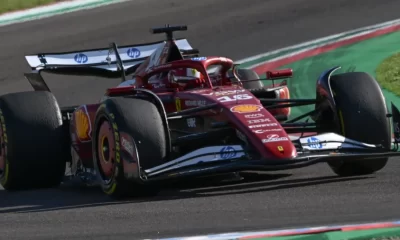Travel
Error fares: How to take advantage of cheap flight deals when airlines make mistakes
This cheap flight hack could secure you tickets at rock bottom prices – but it can be risky.
Looking for cheap flights for your next getaway? Error fares could be your best bet.
As the name suggests, error fares are mistakes made when the price of a flight is listed online. Sometimes tickets are sold for far less than they should be, either due to human error or glitches in the complex systems that determine flight prices.
Savvy travellers can take advantage of these mistakes to secure a cheap holiday – but there are some risks with these low-cost fares.
Here’s everything you need to know about error fares, from how to find them to what could happen when you book them.
Cheap flight hack: How to find error fares
There are various websites and newsletters dedicated to finding cheap flights – including those that specialise in hacks like skiplagging and error fares.
Jack’s Flight Club is one example that delivers flight deals via an email newsletter and mobile app. Rather than offering tickets through its own platform, it redirects users to the airline or travel agency’s booking websites. Subscription is free, though Premium Membership offers access to more discounts.
The service provides alerts for cheap flights departing from all airports in Belgium, Denmark, Germany, Ireland, Luxembourg, the Netherlands, Norway, Sweden and the UK, as well as from Boston, Chicago, New York, Philadelphia and Washington DC in the US.
Secret Flying offers a similar service, with cheap flight deals and mistakes listed on its website and shared with subscribers via email. It searches for deals departing from airports worldwide and is free to use.
You can also set up price alerts for specific routes with aggregation services like Skyscanner or Google Flights.
Error fares are usually rectified or sell out quickly, so you’ll need to act fast to secure a cheap flight.
What are the causes of error fares?
Flight prices are often determined by complex algorithms that adjust them based on data like demand for particular routes or distance.
They may be adjusted further by online travel agencies selling flights as a third party. Sometimes error fares occur when these agents list prices that differ from the airline’s direct pricing – either due to human error or a glitch in the system.
In other cases, conversions from one currency to another may be listed incorrectly, making the flight far cheaper than it should be. The airline may also miscalculate the mileage of connecting flights, resulting in lower taxes.
Airlines sometimes make the mistake of listing a premium, business or first class flight at an economy rate too. This is often where you can make the biggest saving, as economy fares are largely made up of taxes and surcharges which usually remain the same regardless of errors.
As technology improves and AI takes over, error fares are likely to become less common and be rectified faster when they do occur.
What are the risks of booking an error fare?
Error fare tickets are usually honoured by airlines – but this is not guaranteed unless your country has laws to enforce it.
These usually take into account whether the error was obvious enough for the consumer to notice it, how long it was left online, and how quickly the buyer was notified of it.
But passengers taking advantage of these cheap fares should bear in mind that the airline can cancel your flight if it realises the error and decides not to uphold it. In such cases, you are entitled to a full refund. You will not be billed the full price of the ticket without your permission.
For this reason, sites like Jack’s Flight Club and Secret Flying advise against making other travel plans like booking hotels or accommodation until the last minute.
Secret Flying says there is a “small chance” the airline may cancel the ticket. Therefore it is best to book refundable or flexible accommodation if you are planning to fly on an error fare.
If you accidentally book an error flight because the discount was not enough to be deemed abnormal, however, you may be entitled to contest the fare if the airline cancels your flight, or gain compensation from the airline for any extra costs incurred such as hotel bookings.
Jack’s Flight Club says that around 70 per cent of the error fares it lists are honoured by airlines, as they tend to avoid the hassle and bad publicity of cancelling tickets. Once your ticket has been issued, it is less likely to be cancelled.
For the best chance of having your error fare honoured, book directly with the airline and only book tickets listed at plausible discounts.
How much could you save with error fares?
Recent error fares shared by Jack’s Flight Club include a €46 flight from London to Los Angeles with Norwegian; Amsterdam to Peru for €164 with AeroMexico; and Paris to Tokyo for €290 with Aeroflot over the busy Christmas period.
These journeys would usually cost around €410, €800 and €900, respectively.
Secret Flying recently listed business class flights from several German cities to Cusco, Peru from €834 for a round trip with Iberia and LATAM Airlines. Business class flights from Munich typically cost upwards of €3,000.
The site also recently alerted readers to €250 flights from Stockholm, Sweden to Johannesburg, South Africa with Swiss International Air Lines – around half the usual price.
Travel
Brexit complicated travelling with a pet between the UK and EU, but new rules could change that
ADVERTISEMENT
For British travellers, taking a pet abroad to an EU country is now fraught with formalities, from rabies vaccinations to tapeworm treatments.
These complicated procedures are a result of Brexit, which introduced several bureaucratic hurdles that previously did not exist.
However, the recent negotiations for a ‘Brexit reset’ deal between the UK and the EU look set to simplify pet travel rules again.
Here are the current regulations for bringing a pet into the EU and what is expected to change.
How Brexit complicated travelling with a pet between the UK and EU
Before Brexit, UK residents enjoyed straightforward travel with their pets involving minimal paperwork.
Dogs, cats, and other furry companions were stamped in and out using a simple pet passport system.
Pet travel between Great Britain and Northern Ireland was completely unrestricted in both directions.
But Brexit brought in a host of new bureaucratic requirements for Brits travelling with their animals.
The current requirements state that pets must be microchipped. Animals over 12 weeks old must receive a rabies vaccination, and more than three weeks must pass between the jab and travel.
Each journey requires a new EU animal health certificate (AHC) confirming both microchipping and vaccination.
Dogs need tapeworm treatment one to five days before entering the EU or Northern Ireland, with a health certificate issued within 10 days of entry. Vets charge approximately £200 (€236) per certificate.
When entering the EU, travellers must use dedicated entry points where officials will validate and stamp the pet’s documentation.
When returning to the UK, the same certifications used for departure remain valid.
Pet owners report that the paperwork is challenging and prone to errors that can prevent travel altogether.
While the certificates remain valid for up to four months for re-entry to Britain, this exceeds the 90-day limit that applies to British citizens in the EU, so it is irrelevant for most travellers.
Taking your pet to Northern Ireland, Ireland, Finland, Malta or Norway?
While there are still no restrictions on taking a pet from Northern Ireland to Great Britain, the above rules apply in the opposite direction because of the ‘border in the Irish Sea’ that Boris Johnson’s government negotiated.
For direct travel to Ireland, Finland, Malta, or Norway, dogs require veterinarian-administered tapeworm treatment between 24 hours and 5 days before arrival, documented in either the health certificate or a valid pet passport.
How the Brexit reset deal could simplify travelling with your pet
The UK government is seeking to negotiate with the EU to restore something closer to pre-Brexit ease of pet travel.
This would likely involve UK pet passports regaining a similar status to EU documents.
While there’s a small health risk in facilitating more animal movement between countries, officials believe this is outweighed by both social benefits (allowing more people to travel with their pets) and economic advantages for the tourism industry.
Travel
Spain orders removal of more than 65,000 Airbnb tourist rentals it says violate regulations
ADVERTISEMENT
Spain has launched a major clampdown on Airbnb properties, ordering the removal of over 65,000 holiday rental listings across the country that fail to comply with regulations.
The Spanish Consumer Rights Ministry cited several violations, including missing licence numbers, not specifying whether the owner was an individual or a corporation, and discrepancies between listed information and official records.
The crackdown comes against the backdrop of Spain’s growing housing affordability crisis, which has sparked widespread protests over rising rents and home prices.
Many Spaniards blame short-term rentals on platforms like Airbnb for worsening housing shortages, particularly in popular tourist destinations like Madrid and Barcelona.
‘No more excuses’
On Monday, Spain’s Consumer Rights Minister Pablo Bustinduy said the move aimed to address the general “lack of control” and “illegality” in the holiday rental business.
“No more excuses. Enough with protecting those who make a business out of the right to housing in our country,” he told reporters.
The nationwide enforcement primarily targets listings in Madrid, Andalusia, and Catalonia, where tourism is most heavily concentrated.
The ministry said it had notified Airbnb about the noncompliant listings months ago, but that the company had appealed the move in court.
Spain’s government said Madrid’s high court had backed the order sent to Airbnb.
Bustinduy said it involved the immediate removal of 5,800 rental listings from the site. Two subsequent orders would be issued until the total of 65,935 removals is reached, he said.
Airbnb intends to appeal new ruling
Official data shows Spain had approximately 321,000 licensed holiday rentals as of November last year- a 15 per cent increase since 2020 – with many more operating without proper licenses.
The Consumer Rights Ministry opened an investigation into Airbnb in December last year.
Airbnb told Euronews Travel it will continue to appeal against all decisions linked to this case.
“No evidence of rule-breaking by hosts has been put forward, and the decision goes against EU and Spanish law, and a previous ruling by the Spanish Supreme Court,” a spokesperson said.
“The root cause of the affordable housing crisis in Spain is a lack of supply to meet demand. The solution is to build more homes – anything else is a distraction.”
The spokesperson added that governments across the world are seeing that regulating Airbnb does not alleviate housing concerns or return homes to the market: “It only hurts local families who rely on hosting to afford their homes and rising costs.”
Barcelona bans short-term rentals
Last year, the Spanish government launched a general crackdown on holiday rentals amid growing frustration among residents who say mass tourism is aggravating a housing crisis.
Locals say they are being priced out of their cities due to gentrification and landlords favouring more lucrative short-term tourist lets.
Barcelona has already taken aggressive measures to address the problem, announcing plans to eliminate all 10,000 licensed short-term rental apartments by 2028 to prioritise housing for permanent residents.
Travel
Brits could soon enjoy shorter passport control queues at EU airports. Here’s why
British holidaymakers will soon be able to use e-gates at more EU airports, the UK government has announced.
It comes as part of negotiations between the UK government and the European Union to finalise a ‘post-Brexit reset deal’.
It means British passport holders will no longer have to wait at manned desks and will instead be allowed to use fast-track e-gates usually reserved for EU or European Economic Area citizens.
EU Relations Minister Nick Thomas-Symonds said this would give British travellers “more time to spend on holiday or work trips […] doing what you want, not being stuck in queues.”
The UK government said the move would end “the dreaded queues at border control.”
UK travellers have to join ‘other nations’ queue at EU airports
Following Brexit, UK citizens forfeited their privileged status when travelling to EU countries.
They now fall into the ‘visa-exempt third-country nationals’ category – the same classification as travellers from dozens of countries, including Australia, Canada, New Zealand and Singapore.
This has meant British travellers must join the ‘other nations’ queue at border control rather than using the expedited EU lanes.
The requirement to check that British travellers meet entry conditions is a significant obstacle to allowing them to use the fast-track lanes.
EU border control has to verify that UK travellers are not in breach of the 90-day stay limit in 180 days and that they have the means to return to their country of origin, i.e. a flight ticket out of the EU.
Frontier officials must also stamp the passenger’s passport.
This change often translates to extended waiting times, especially at busy European airports like Amsterdam Schiphol, Milan Malpensa, and Paris Charles de Gaulle.
Waits exceeding an hour have become commonplace, especially when arriving shortly after large international flights.
These delays affect not only entry into EU countries but also departure, as British travellers must undergo exit checks that sometimes result in missed flights due to lengthy queues.
UK travellers will be able to use e-gates at many European airports
Under the new deal, British travellers will be able to take advantage of the faster e-gate passport checks at many EU airports.
No details have yet been released on when this will be introduced and where, although the BBC reported that British Prime Minister Keir Starmer “has called on all EU members to co-operate without delay.”
Some EU airports will likely allow UK travellers to use existing e-gates reserved for EU citizens, while others may install dedicated ‘third-country national’ e-gates.
The latter are already in place across Italy, including Venice Marco Polo and Rome Fiumicino, as well as at Amsterdam Schiphol and Lisbon.
With this system, once the traveller passes through the gate, there is a brief check by border officials who will also stamp passports.
Brits will use e-gates in all airports after introduction of EES
In addition, the UK government underlined that there will be “no legal barriers to e-gate use for British Nationals travelling to and from European Union Member States after the introduction of the European Union Entry/Exit System [EES].”
The EES is scheduled to come into force in October this year. The system will register non-EU visitors who don’t need a visa digitally, removing the need for physical stamps.
New pet passports will make it easier for Brits to bring pets into EU
The UK government also announced that new pet passports will be introduced as part of the deal.
This means UK cats and dogs will be able to travel “more easily” from the UK into the EU by “eliminating the need for animal health certificates for every trip.”
-

 EU & the World5 days ago
EU & the World5 days agoChris Brown Tour 2025: Updates on Concert Dates, Cities, Ticket Prices & More
-

 EU & the World6 days ago
EU & the World6 days agoWho Is Ben Cohen? About the Ben & Jerry’s Co-Founder Who Was Arrested During Senate Hearing
-

 EU & the World4 days ago
EU & the World4 days agoJosh Freese: 5 Things to Know About the Former Foo Fighters Drummer
-

 EU & the World6 days ago
EU & the World6 days agoChris Brown’s Net Worth: How Much Money He Makes Now
-

 Sports3 days ago
Sports3 days agoJannik Sinner doesn’t lose his smile: his message blows the Rome audience away
-

 EU & the World3 days ago
EU & the World3 days agoWhat Time Does ‘The Last of Us’ Air? When to Watch Season 2 Episodes
-

 Sports5 days ago
Sports5 days agoFerrari, opposing views after first day at Imola for Charles Leclerc and Lewis Hamilton
-

 Entertainment5 days ago
Entertainment5 days agoEurovision 2025: Music, Politics, and the Final 26 Set Amid Controversy and Spectacle









